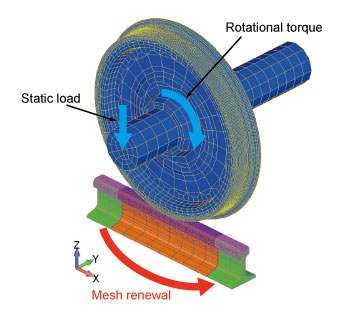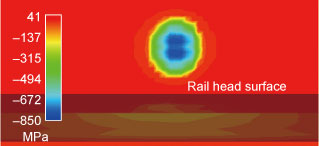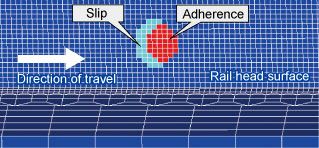1. Method for dynamic analysis of wheel/rail rolling contact
- In order to assess the state of dynamic rolling contact between the rail and the wheel, the finite element analysis program in a large scale parallel computing was developed.
- Dynamic rolling contact behaviour for a single axle - single wheel model when running at high speed was calculated with high precision
It is important to estimate the dynamic behaviour of the wheel/rail contact surface with sufficiently accuracy to determine the deterioration mechanism. Therefore, the three dimensional finite element analysis program considering elasto-plasticity in a large scale parallel computing was developed to evaluate wheel/rail rolling contact problem.
To achieve a speed of 300km/h by applying rotational torque to the wheel, a proposal was made for a rail model (Caterpillar mesh) which reuses the mesh model of the passing wheel (Fig.1). Based on this proposal, it is possible to handle long rolling distances without increasing the scale of the calculation.
Reflection of the elasticity wave generated by the rolling wheel at the edge of rail model affects evaluation of the high frequency response on the contact surface; therefore, an anti-reflective boundary was incorporated into the rail model in order to avoid this occurring. Furthermore a parallel computation method using a supercomputer was built to solve the large scale model into a small size mesh in a realistic time.
With the developed analysis method, it is possible to reproduce a model of the dynamic rolling contact behaviour for one axle and one wheel model running at a speed of 300km/h. This in turn has made it possible to evaluate the response (Fig.2) adherence and slip state (Fig.3) of the contact surface. The developed analysis program is also useful as a tool for gaining insight into mechanisms causing rail corrugation and shearing.

Fig.1 Caterpillar mesh analysis model
Fig.2 Vertical direction stress distribution of contact surface
Fig.3 Adherence and slip distribution areas